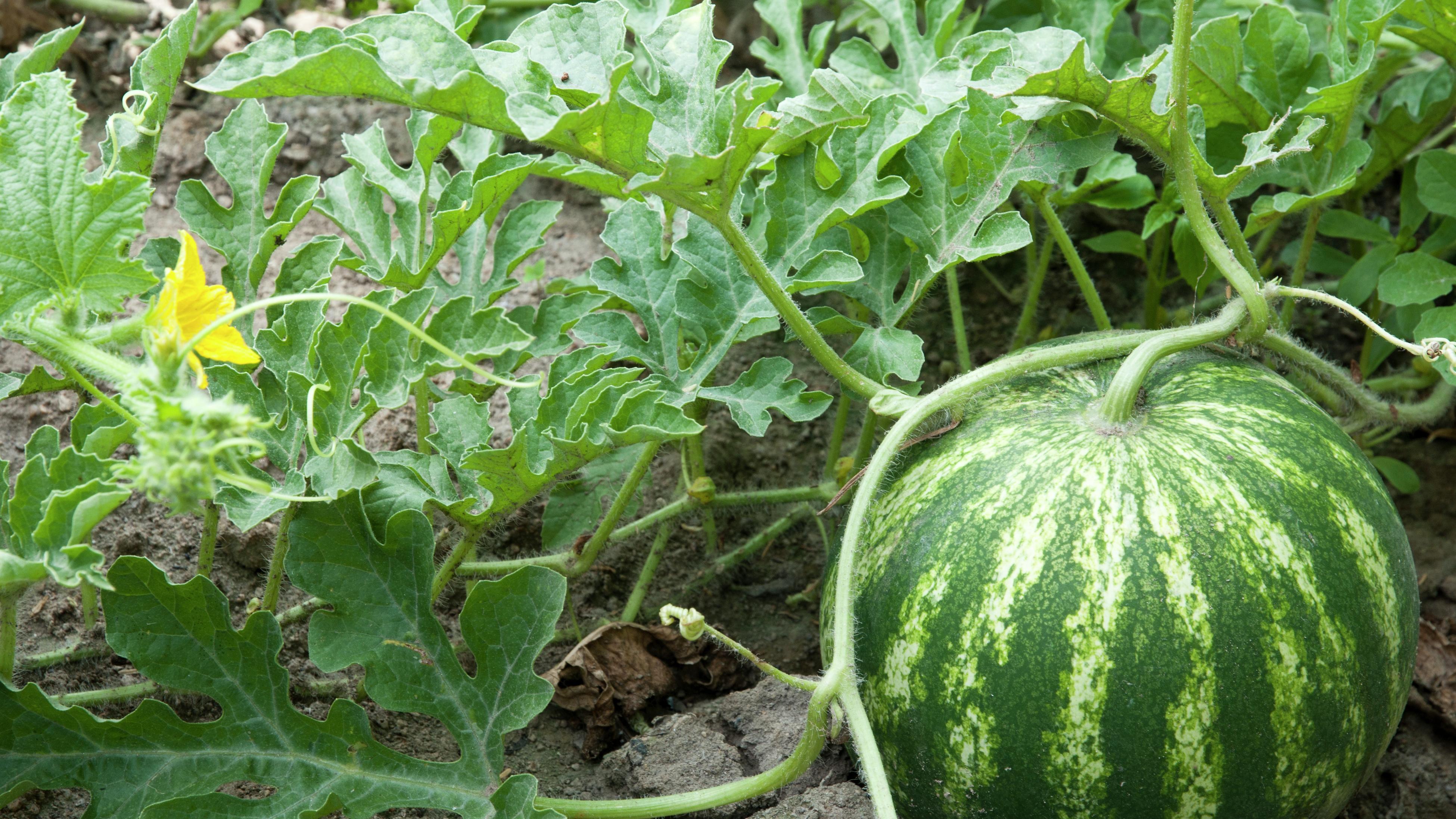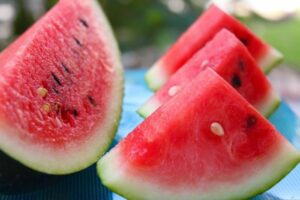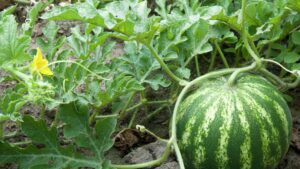What does a watermelon plant look like? Prepare to embark on an intriguing journey into the realm of nature’s artistry as we unveil the captivating features of this beloved fruit-bearing vine.
Watermelon plants are characterized by their sprawling vines, lush foliage, and the promise of sweet, juicy fruits. Their appearance is a testament to nature’s intricate design, with each element playing a vital role in the plant’s growth and productivity.
General Appearance
The watermelon plant is a sprawling vine that can grow up to 20 feet long. It has large, deeply lobed leaves that are typically dark green in color and have a slightly rough texture. The plant produces both male and female flowers, which are small and yellow in color. The male flowers appear first, followed by the female flowers. Once the female flowers are pollinated, they will develop into watermelons.
Growth Pattern and Vine Structure
The watermelon plant grows by sending out long, slender vines that trail along the ground or climb up trellises or other supports. The vines have tendrils that help them to attach to surfaces. The leaves are arranged alternately along the vines, and the flowers and fruit are produced at the nodes where the leaves attach to the vines.
Leaves
Watermelon plants produce large, deeply lobed leaves that provide a canopy over the sprawling vines. These leaves play a crucial role in photosynthesis, enabling the plant to convert sunlight into energy for growth and fruit production.
Like an emerald vine, the watermelon plant sprawls across the ground, its tendrils reaching out like grasping hands. Its leaves, a vibrant tapestry of green, dance in the gentle breeze. But beneath this verdant canopy lies a secret – the rind of the watermelon itself.
While its sweet, juicy flesh is a summer delicacy, the rind often goes uneaten. But what if I told you that this discarded part holds nutritional treasures? Can you eat the rind of a watermelon ? The answer may surprise you.
Shape and Size
- Watermelon leaves are typically triangular or heart-shaped, with deep incisions that divide the blade into distinct lobes.
- The leaves can grow quite large, reaching lengths of up to 2 feet and widths of 1.5 feet.
Arrangement
The leaves are arranged alternately along the stem, with each leaf emerging from a different node. The petioles, or leaf stalks, are long and slender, allowing the leaves to spread out and capture maximum sunlight.
Margins and Venation
- The leaf margins are serrated, with small, pointed teeth along the edges.
- The venation pattern is palmate, with veins radiating out from the base of the leaf blade towards the lobes.
Markings and Textures
Watermelon leaves often have a distinctive mottled appearance, with patches of light and dark green coloration. The upper surface of the leaves is smooth, while the underside may have a slightly hairy texture.
Stems
The stems of a watermelon plant are long, slender, and vine-like. They can reach a length of up to 15 feet (4.5 meters) and are typically green in color. The stems are covered in fine hairs and have a slightly rough texture. They grow in a zigzag pattern, branching out to form a dense network of vines that can cover a large area of ground.
The watermelon plant is a vine with large, lobed leaves. It produces large, round fruit with a hard green rind and a sweet, juicy red flesh. The plant has tendrils that help it climb up trellises or other supports. If you want to learn how to draw a watermelon, there are many tutorials available online.
You can find a step-by-step guide here . Once you have mastered the basics of drawing a watermelon, you can experiment with different colors and textures to create your own unique artwork. The watermelon plant is a beautiful and versatile subject for artists of all levels.
The stems of a watermelon plant are not thorny or spiny. However, they can be quite prickly, especially when the plant is young. The prickles can cause irritation to the skin, so it is important to wear gloves when handling the plant.
Flowers
Watermelon plants produce beautiful, vibrant flowers that play a crucial role in the fruit’s development. These flowers are not only aesthetically pleasing but also essential for pollination and subsequent fruit formation.
Beneath a cerulean canopy, where the sun’s embrace paints the earth with vibrant hues, there flourishes a marvel of nature: the watermelon plant. Its sprawling vines weave intricate tapestries upon the ground, adorned with verdant leaves that whisper secrets to the gentle breeze.
Amidst this tapestry, plump orbs emerge, their emerald rinds speckled with darker shades, promising a symphony of sweetness. But as the twilight’s embrace descends, a celestial spectacle unfolds – a celestial display of twinkling watermelon, beckoning the curious to witness a celestial dance where to watch twinkling watermelon – before returning to the familiar sight of the watermelon plant, its bounty patiently awaiting the dawn’s embrace.
Size, Shape, and Color
Watermelon flowers are relatively large, with a diameter ranging from 2 to 4 inches (5 to 10 cm). They have a distinctive shape, resembling a trumpet or funnel. The petals are delicate and papery, arranged in a single layer. The flowers come in various shades of yellow, from pale cream to bright golden yellow. Some varieties may also have orange or red accents on the petals.
Flowering Period and Duration
Watermelon plants typically bloom in the summer months, around 40 to 60 days after planting. The flowering period lasts for several weeks, allowing ample time for pollination and fruit set. Each flower remains open for only one day, but new flowers continue to emerge throughout the flowering period.
The watermelon plant is a sprawling vine with large, deeply lobed leaves. It produces large, round fruits with a hard, green rind and a juicy, red flesh. The fruits are typically 12 to 18 inches in diameter and weigh between 20 and 40 pounds.
Watermelon is a popular summer fruit that is often eaten fresh, but it can also be used in salads, desserts, and other dishes. In addition to humans, watermelon can also be eaten by goats. Can goats eat watermelon ? Yes, goats can eat watermelon, but it should be given to them in moderation.
Watermelon is a good source of water and nutrients for goats, but it is also high in sugar, so it should not be given to them too often.
Pollination Mechanism and Attractants, What does a watermelon plant look like
Watermelon flowers are monoecious, meaning that both male and female reproductive organs are present on the same plant. The male flowers are smaller and have long, slender stalks, while the female flowers are larger and have a short, stout stalk with a small ovary at its base. Cross-pollination is necessary for fruit production, and it is primarily facilitated by insects, especially bees. The flowers produce a sweet nectar that attracts bees and other pollinators. The bright yellow color of the petals also serves as an attractant, guiding pollinators towards the flowers.
The watermelon plant, a vine that sprawls along the ground, bears large, round fruits with a hard rind and juicy, sweet flesh. These fruits, which can weigh up to 20 pounds, are a summer staple and a refreshing treat on hot days.
But how long is a watermelon good for? Click here to find out how to store and enjoy your watermelon for as long as possible. Once cut, watermelon should be refrigerated and consumed within 3-4 days. The vine itself, with its deeply lobed leaves and tendrils that cling to trellises or other supports, adds a touch of greenery to any garden.
Fruits (Watermelons)
The fruits of the watermelon plant, known as watermelons, are the defining characteristic of this species. They are large, round, and heavy, with a hard rind and juicy, sweet flesh.
Shape and Size
Watermelons are typically spherical or oblong in shape, with a smooth, slightly bumpy surface. They can vary greatly in size, ranging from small, personal-sized melons to massive specimens that can weigh over 100 pounds (45 kilograms).
Rind
The rind of a watermelon is thick and tough, providing protection for the delicate flesh inside. It can vary in color from light green to dark green, with some varieties featuring stripes or patterns. The texture of the rind can be smooth or slightly ribbed.
Flesh
The flesh of a watermelon is the edible portion of the fruit. It is typically bright red or pink in color, although some varieties may have yellow or orange flesh. The flesh is juicy and sweet, with a high water content that makes it refreshing and thirst-quenching.
Last Word: What Does A Watermelon Plant Look Like

From the sprawling vines to the vibrant fruits, watermelon plants are a testament to nature’s boundless creativity. Their unique characteristics not only enhance the beauty of our gardens but also provide us with a delicious and refreshing treat. As we delve deeper into the world of watermelon plants, we continue to marvel at their intricate details and the vital role they play in our ecosystem.
User Queries
How tall can a watermelon plant grow?
Watermelon plants can grow up to 10-15 feet in length, with vines trailing along the ground or climbing trellises.
What color are watermelon plant leaves?
Watermelon plant leaves are typically deep green in color, with deeply lobed edges and prominent veins.
When do watermelon plants flower?
Watermelon plants produce bright yellow flowers that bloom in the morning and close by afternoon.
How big can watermelons grow?
Watermelons can vary in size, with some varieties producing fruits that weigh up to 20 pounds or more.







Leave a Comment